Institute for Policy Studies and Media Development and United Nations Development Program in Vietnam[1]
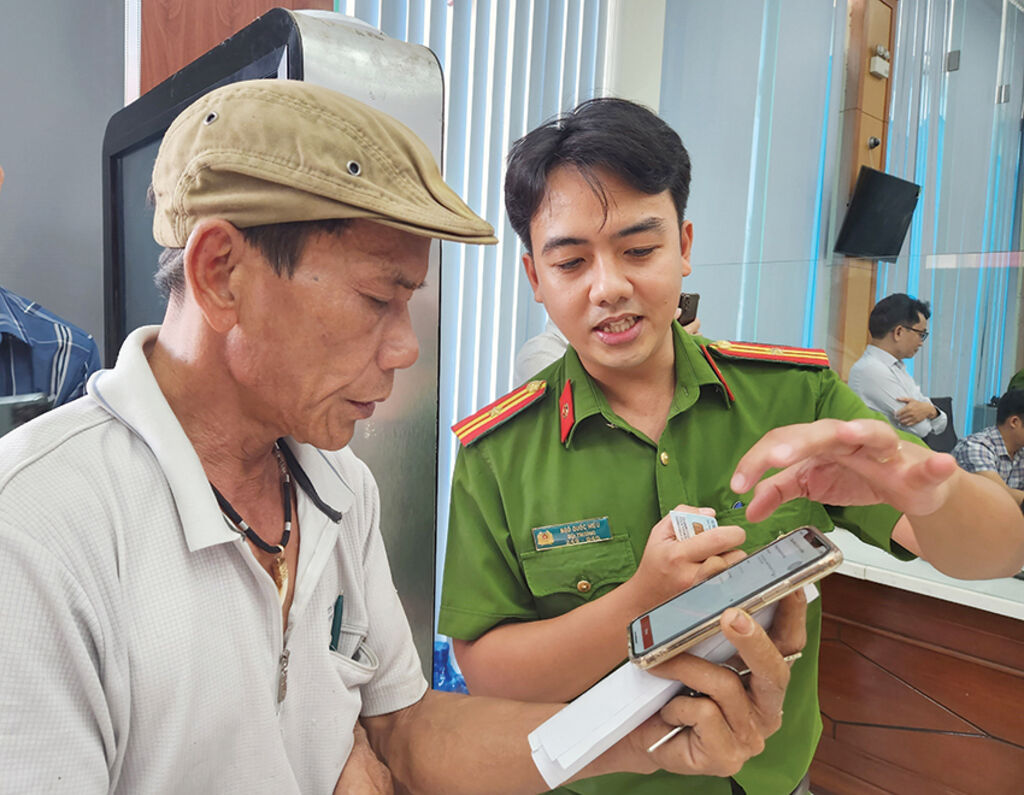 |
| Police officers guide people through the process of applying for a criminal record certificate on the VNeID app__Photo: VNA |
Introduction
The provision of online public administrative services (OPASs) is Vietnam’s top priority within the nation’s programs and strategies for digital transformation, e-government, digital economy, digital society, and administrative reform. These initiatives emphasize a user-centered approach, with user satisfaction serving as a key measure of evaluation. Ministries, agencies, and local authorities have developed and operated an information system for handling administrative procedures to provide OPASs to citizens and businesses, of which public e-service portals (PESPs) are a core component.
However, the utilization of OPASs has remained consistently low. According to reports from the 9th meeting of the National Committee for Digital Transformation in July 2024, the rate of eligible full-cycle administrative procedures reached only 48 percent, while the rate of online submissions for full-cycle OPASs at the provincial level was merely 17 percent. The 2023 Vietnam Provincial Governance and Public Administration Performance Index (PAPI) recorded an even lower rate of PESP users at only 7.6 percent. If this low rate of PESP users for OPAS continues, achieving the target of having at least 70 percent of public administrative procedures provided online at the provincial level by 2025 will be challenging.
Applying the 2023 review approach with several new and updated indicators,[2] a second review of 63 PESPs was conducted with the participation of a selection of users, including researchers, people with disabilities, ethnic minorities, and islanders in the first half of 2024. As presented in Figure 1, the evaluation criteria are divided into four sets: (i) PESP interfaces; (ii) features and tools to guide users before performing administrative procedures on PESPs; (iii) features and tools to support users in executing administrative procedures on PESPs; and (iv) assurance of the rights and interests of users on PESPs.
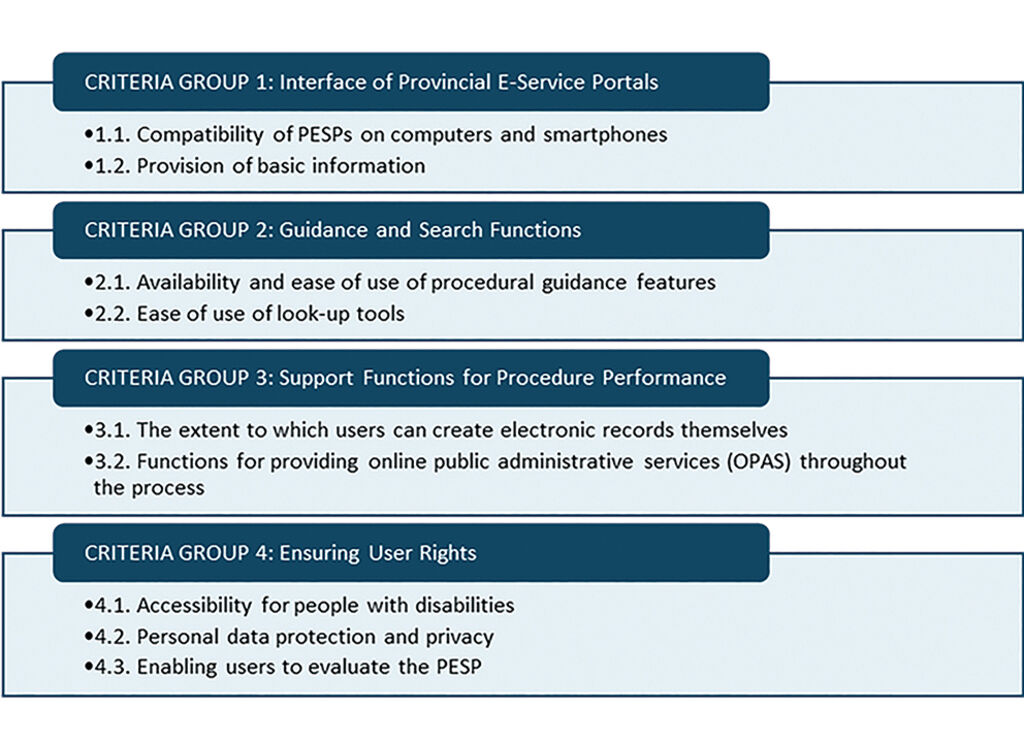 |
| Figure 1: Evaluation scope and criteria to assess the performance of 63 PESPs |
This article presents key findings and recommendations from the second user-driven review of PESPs of all 63 provinces conducted in 2024, following the first round in 2023.[3] The purposes of this series of PESP performance reviews are to propose measures to enhance the performance of PESPs and to suggest policy actions for developing user-centered OPASs in Vietnam.
Review approach and key findings
In the second review of 63 PESPs in 2024, the user-friendliness, accessibility, and availability of the PESPs and the OPASs provided therein were evaluated from the user’s perspective. This evaluation included the participation of people with disabilities, ethnic minorities, and islanders, based on four dimensions. As listed in Figure 1, PESPs were assessed against the performance of their interfaces, the features and tools available to guide users before performing OPASs, and the protection of users’ privacy rights on PESPs. Additionally, the evaluation examined a selection of citizen-centric OPASs provided on PESPs, focusing on the extent to which user needs are met, their synchronization, level of transparency, specialization, effectiveness, and factors influencing OPAS delivery.
Overall, the 2024 evaluation of the 63 PESPs indicates improvements in the provision of OPASs across some evaluation criteria compared to the 2023 findings. For instance, many PESPs performed well in the criteria “Provision of basic information” and “Ease of use of lookup tools.” However, all 63 PESPs exhibited inconvenient aspects for both government officials and the public, particularly for users in remote areas, islanders, and people with disabilities. As many as 60 PESPs did not meet the criterion “Personal data protection and privacy,” while 39 PESPs failed to meet the “Accessibility for people with disabilities” criterion. There remains significant room for improvement in terms of convenience, user-friendliness, and accessibility across all 63 PESPs. Below are the key detailed findings derived from the 2024 review of PESPs.
All 63 PESPs failing tests on convenience, ease of use, and accessibility
All 63 PESPs have inconvenient aspects, especially for users in remote areas, islanders, and people with disabilities. As shown in Figure 2, none of 63 PESPs has attained more than 50 percent of the evaluation criteria at a “good” level. Even Phu Tho province’s PESP, which scored the highest, only met the “good” level in four out of nine criteria. Additionally, the differences between PESPs’ evaluation scores are minimal. This indicates that all 63 PESPs have room for improvement in terms of convenience, user-friendliness, and accessibility.
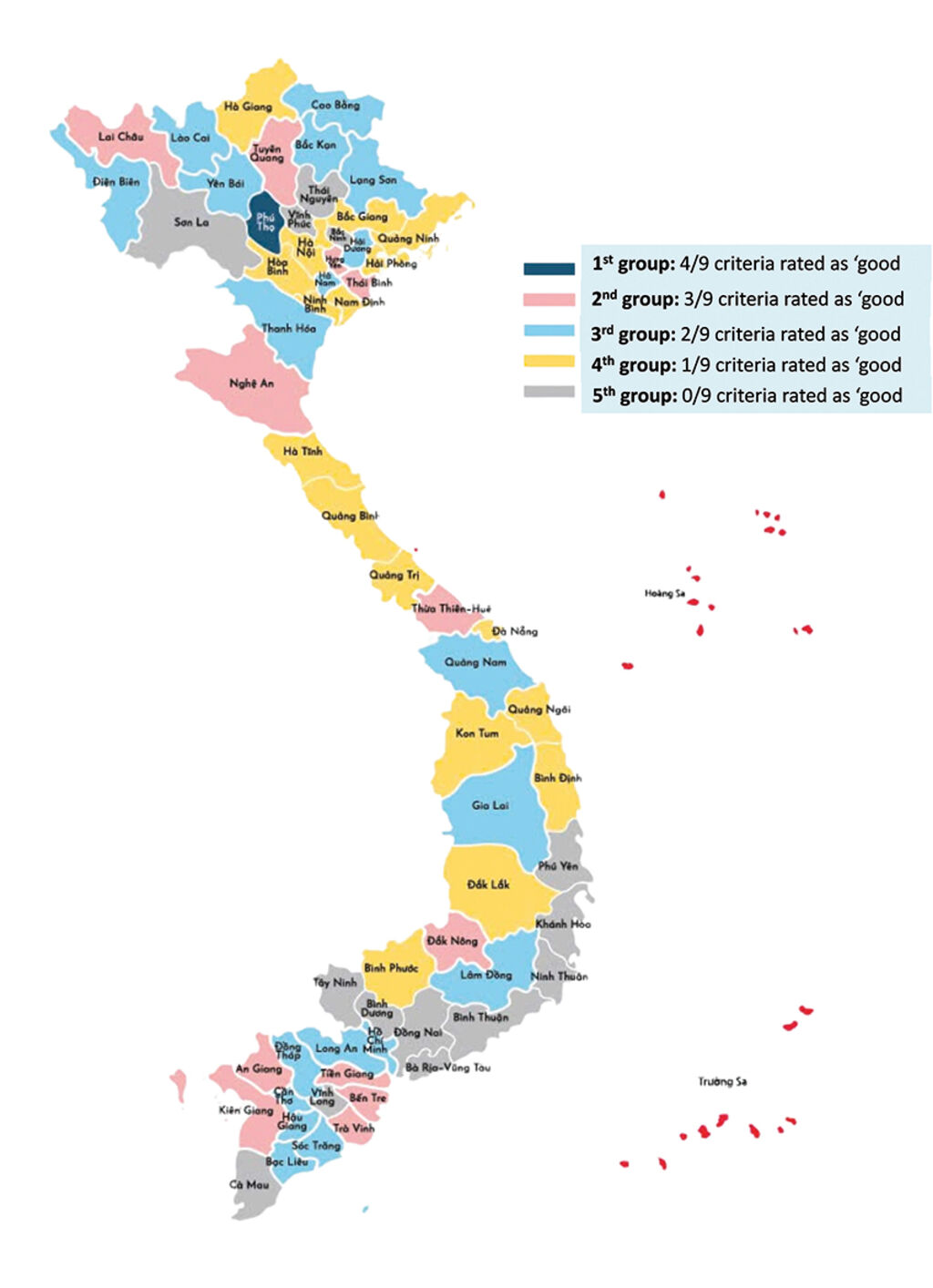 |
| Figure 2: Performance assessment results of 63 PESPs as classified into five performance levels |
Also, considering Vietnam’s geographical regions, four (i.e., Tay Ninh, Binh Duong, Dong Nai, and Ba Ria-Vung Tau) out of six provinces in the Southeast region have no criteria rated as “good”. Besides, four (i.e., Ninh Thuan, Binh Thuan, Phu Yen, and Khanh Hoa) out of eight provinces in the Central Coast region have no criteria rated as “good”. Provinces in the North Central and Central Highlands regions have at least one out of nine criteria rated “good”. In terms of implementation of criminal record services, four out of five provinces in the Central Highlands achieve a ‘“good” level of the criterion “Level of completion of features so that public services are provided online throughout the entire process”. The level of fulfilling requirements on OPASs provision belongs to the average group among PESPs of provinces/cities having better technological development conditions (Hanoi, Ho Chi Minh City, Da Nang, Hai Phong, Quang Ninh, and Can Tho).
This finding highlights that localities having good infrastructure and technological development have not necessarily performed well in OPASs provision. Meanwhile, several localities with less developed technological conditions have achieved better results compared to others nationwide.
None of 63 PESPs fully meet criteria on convenience, ease of use, and accessibility. The review results in 2024 shows improvement in the provision of OPASs on 63 PESPs in several evaluation criteria compared to the 2023 findings. However, there are significant limitations in terms of access to PESPs, availability of essential information, guidance on document submission, availability of full-cycle OPASs, and accessibility of PEPSs for people with disabilities.
Only 24 PESPs performed well in the “Provision of basic information” criterion and 22 PESPs performed well in the “Ease of use of lookup tools” criterion. This suggests that basic functions such as searching and information retrieving are being prioritized for improvement. Specifically, for online services of provision of criminal records, 30 PESPs achieved a “good” level in the criterion “Level of completion of features so that public services are provided online throughout the entire process.”
Most PESPs were at the average level in terms of compatibility with both computers and smartphones. As presented in Figure 3, up to 60 PESPs were rated “fair” and “good” in the criteria “Compatibility on computers” and “Compatibility on smartphones”. Currently, administrative procedures are difficult to be done on smartphones while more than 90 percent of citizens now use this device. To meet these two criteria, PESPs need significant technical improvements.
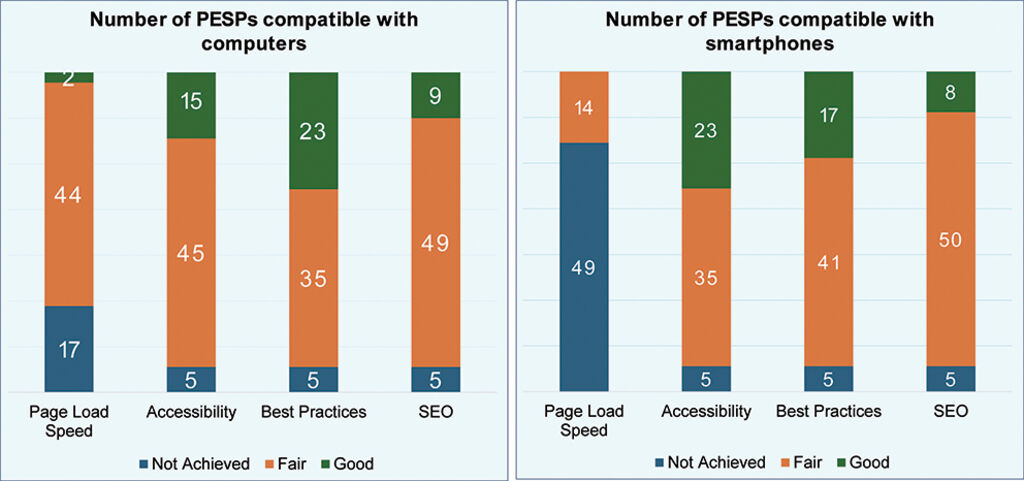 |
| Figure 3: Compatibility of PESPs on computers vs. on smartphones |
Provinces with good infrastructure and technology development do not necessarily implement well on their PESPs, and vice versa. Centrally run municipalities of Hanoi and Ho Chi Minh City were at an average level, while poorer provinces with lower level of technology application such as Phu Tho, Tuyen Quang, Lai Chau, Dak Nong, Tra Vinh, Tien Giang, Ben Tre, and An Giang received higher ratings for their PESPs.
Chatbots to assist users are neither functional nor substantive. Chatbots designed to provide basic guidance for users of OPASs have been found on 33 PESPs in 2024, a significant rise from 15 PESPs in 2023. Of the number, seven on PEPSs of Son La, Yen Bai, Lang Son, Nghe An, Binh Dinh, Binh Thuan, and Dak Lak show voice-to-text options. However, at the time of the review, only 19 chatbots were functional with basic prompting hints; while the remaining 14 chatbots were either inactive, unresponsive to queries, or provided incorrect responses (see Figure 4).
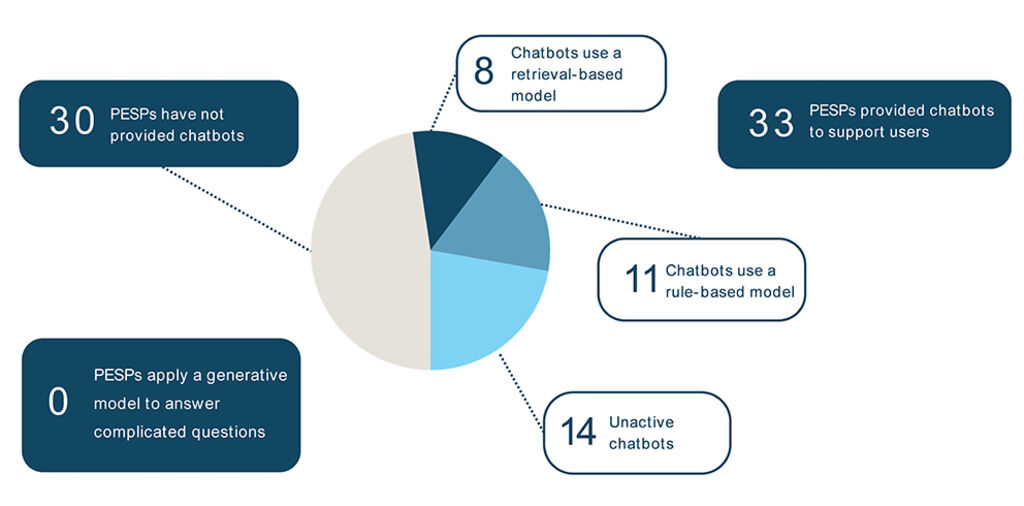 |
| Figure 4: Chatbots on PESPs neither deep nor substantive |
Behind the numbers: Factors influencing user experience with online public administrative services
In-depth analysis from this study and users’ feedback across 63 PESPs reveal important limitations in meeting user needs, synchronization, transparency, and specialization. The provision of public administrative procedures on 63 PESPs is more influenced by administrative processes, infrastructure, technology, human resources, and support measures.
Most users must rely on direct guidance or assistance from civil servants at physical one-stop shops when using OPASs on PESPs. Reported issues on PESPs’ opinion sections indicate that many applicants for public administrative papers had to visit state agencies’ one-stop shops in person to complete administrative procedures. This shows that PESPs have not yet achieved their primary goal to support users, especially those living in remote areas, islanders and people with disabilities, to access and process OPASs from anywhere but not the physical one-stop shops.
Consistency and synchronization in public administrative service provision across provincial and national ESPs is poor. Although there was progress in 2024 compared to 2023, users still have had to struggle with varying interfaces and implementation methods on PESPs due to a lack of the linkage between PESPs and the National E-Service Portal or with ministries’ ESPs. Issues remain in the synchronization of interface design, process guidance, procedures, and weblink structures across PESPs.
Transparency in the workflow of public administrative procedure handling on PESPs is limited. While PESPs are doing well in publicizing the status of administrative procedures, there is still a need to improve the provision of detailed and transparent information about the process for handling administrative procedures, making it difficult for users to understand OPAS steps. Users have faced challenges in completing the steps on PESPs and tracking the progress of their applications due to a lack of updated information at each stage.
Features and tools for document submission and online procedures are not following a digital process using web-based e-forms. Users still have had to submit hand-signed PDF files onto OPAS links. Collected citizen data and already-digitized data held by state agencies have not been utilized in OPAS and on PESPs to simplify the electronic application process. Features like manuals, search engines, information lookups, virtual assistants, and privacy protections are either inconvenient or unavailable. Additionally, users have faced difficulty in making online payments on PESPs.
Public administrative processes and procedures remain unfit for online services. Most public administrative procedures are inherently complicated as they involve multiple layers of governments and state agencies. Meanwhile, OPASs on PESPs are still processed on the basis of administrative processes and procedures being applied for traditional, in-person interactions. This conventional approach is a key challenge for effective delivery of OPASs.
Limitations in technical infrastructure have reduced the effectiveness of OPAS provision. Many localities, particularly in poor communes, mountainous areas, islands, and regions with weak connectivity, struggle with inadequate technical infrastructure, leading to unstable and inefficient online service provision.
The digital competency of cadres, civil servants and public employees across different government levels is inconsistent. The varying levels of digital competency and skills among cadres, civil servants and public employees have affected the quality of support and the processing of user documents in the online environment. Additionally, local civil servants have been overwhelmed by the increased workload in handling administrative procedures both offline and online, as they often need to provide direct guidance or complete tasks on behalf of OPAS users.
Support for performing OPASs is not yet effective. Various initiatives to encourage the use of online services, such as fee exemptions, non-terrestrial administrative procedures, and the Community Digital Technology Teams, have not attracted users to self-service at home. Most users have still relied on direct support from civil servants at physical local one-stop shops.
Recommendations: innovation from mindset to action
The findings above indicate that there is significant room for improvement in PESPs to ensure that these OPAS-facilitated platforms are convenient, user-friendly, and accessible to meet the needs of users from all demographic backgrounds. Below are specific recommendations for central and provincial governments to consider adopting.
Embracing a digital-first approach with a user-centered focus - or a digital governance mindset
The development and implementation of policies regarding OPASs must embrace a digital governance mindset. Leveraging digital technology, connecting digital data, and delivering services through digital platforms necessitate the elimination of outdated geographical administrative barriers in our increasingly interconnected public service environment. Traditional paper-based administrative processes are no longer suitable in this context. A “digital governance” approach also underscores the significance of data, data sharing, and data integration, as data is essential for delivering OPASs. This mindset promotes interaction between the Government and citizens on digital platforms, gradually reducing the reliance on in-person interactions for the provision and utilization of public administrative services.
The development and implementation of policies for public administrative services, including public service delivery, must begin with and adhere to the principle of “user-centered design,” using user satisfaction as the primary metric. This principle should guide the entire process of designing, building, and delivering public services. In addition to service provision, it is crucial to continuously review and assess the effectiveness of these services, particularly user-friendliness, ease of use, consistency, and continuity. Special attention must be paid to the needs of individuals in remote areas, islanders, and those facing challenges related to mobility, hearing, vision, or proficiency in the Vietnamese language when providing OPASs.
Improving the delivery of OPASs
Enhancing the quality of OPASs to attract users. Focus should be placed on improving the efficiency of essential OPASs that are frequently used and have a high transaction volume related to the lifecycle of individuals at both national and local levels. Digitalization efforts should prioritize public administrative procedures that have demonstrated consistent online transactions, while lower priority can be given to those having not generated online activity for an extended period. When delegating targets for delivering OPASs to lower levels of government, it is important to consider the socio-economic conditions of each locality and the appropriate capacity of government agencies. This approach will help avoid placing undue pressure that could lead to unreliable and inaccurate reporting on user rates, ultimately hindering the digital capability of both civil servants and citizens.
Self-reviewing OPASs platforms to maintain “user-centered services”. Provinces should conduct self-reviews of their OPAS platforms to maintain a focus on “user-centered services.” It is essential to address and rectify any technical errors on their PESPs. Priority should be given to enhancing features and tools that significantly impact the rights and needs of all users. This includes improving page loading speed, implementing interactive electronic forms instead of requiring users to download forms as images or compressed files, and designing smartphone-friendly electronic forms for OPASs, all in accordance with local technical conditions and budget constraints. Additionally, it is important to streamline internal processes within and between state agencies before digitalizing single-sector administrative procedures that are legally favorable for OPASs, such as simplifying the processes for administrative procedures already mandated for full online operation.
Enhancing the effectiveness of OPASs. It is vital to supplement and improve features and tools that enable users to complete documents and administrative procedures entirely online, with online payment playing a key role. OPASs should evolve from merely digitizing administrative procedure documents to fully digitizing the entire process of performing administrative procedures. This involves connecting, sharing, and utilizing existing information and data more effectively. Gradually expanding features, tools, and applications to create smartphone-friendly OPASs will help meet the needs of a broader user base. Moreover, government agencies must simplify the processes and procedures for handling frequently encountered administrative tasks.
Ensuring publicity and transparency of OPAS providers. The PESPs must provide comprehensive information, including email addresses and phone numbers, for all agencies and units responsible for delivering services, enabling citizens to reach out with questions or feedback. PESPs should be equipped with tracking functions similar to those used by goods delivery and taxi apps, allowing users to track the pathway of their applied procedures. Information regarding the focal point responsible for monitoring and updating OPAS results should be made public, accompanied by an automatic notification mechanism that informs organizations and individuals via email or Zalo of the status of their OPAS requests.
Finalizing the national policy framework and promoting the innovation of OPASs
Finalizing legal documents related to OPASs. It is essential to finalize and thoroughly implement the policies outlined in the 2023 Law on E-Transactions, which represents a foundational shift in digital transformation, including the provision of OPASs. This is particularly important in such areas as the legal validity of e-transactions, data messages, and full-process e-transactions. Regulations that currently prohibit the performance of administrative procedures in the electronic environment should be amended to narrow or eliminate the requirements for in-person interactions, thereby facilitating the implementation of online services. Additionally, it is important to review, streamline, or even eliminate administrative processes and procedures that no longer align with the digital environment.
Exempting or reducing fees for citizens using OPASs. Consideration should be given to increasing fee exemptions and reductions, as well as expanding the range of administrative procedures eligible for such exemptions or reductions for citizens using OPASs. Potential compensation for these exemptions could be sourced from local government budgets. Initially, local governments could waive or reduce fees for all organizations and individuals using OPASs. After an initial implementation period, these exemptions and reductions should be specifically targeted at disadvantaged groups, including the poor, near-poor, ethnic minorities, and residents of underserved areas.
Performing non-terrestrial administrative procedures. This measure should be implemented in regions where residents must travel long distances, such as mountainous or island areas, or for temporary residents in large cities, particularly for high-volume, straightforward administrative procedures. Civil servants at public administrative service centers or one-stop shops at district and commune levels should be encouraged and motivated to digitize entire application files from the moment of initial receipt. It is also crucial to address issues of authority, processes, procedures, and coordination between different levels of government when implementing this policy.
Diversifying financial resources for OPAS delivery. In accordance with the 2023 Law on E-Transactions, government agencies can utilize annual state budgets to hire consultants for building databases, managing operations, and ensuring cybersecurity for information and technology (IT) systems that support OPASs. Additionally, resources from the national target programs can be utilized, and contributions from businesses can be mobilized to enhance IT equipment, thereby improving the provision and accessibility of public services in remote and underserved areas.
Enhancing capacity of cadres, civil servants, and public employees in handling OPASs. A competency framework for OPAS provision should be developed for cadres, civil servants, and public employees, particularly at the commune level. This framework should integrate online public service provision skills into civil servant training programs. Specific training contents could include skills for using OPAS software, processing applications online, guiding and assisting citizens in completing administrative procedures online, and ensuring information security - especially when using social networking applications for communication with OPAS users.
Increasing public awareness of PEPSs. Efforts should focus on raising public awareness of PEPSs, beginning with community digitalization support teams, Youth Unions, and community meetings to ensure that every household has at least one person who is familiar with how to use PEPSs. More creative approaches to promoting PEPSs should be developed, such as organizing competitions (e.g., Hackathons) to encourage youth initiatives aimed at improving public administrative service delivery, thereby attracting greater public attention to PEPSs.
Establishing a single National E-Service Portal toward 2030. In the long term, aiming for 2030, it may be necessary to establish a single National E-Service Portal (NESP) that serves as a unified portal for all OPASs, following the examples set by leading e-government countries such as the Republic of Korea, the United Kingdom, and Australia. The structure of this unified NESP should include six sections: (i) a search engine for public administrative services; (ii) provision of OPASs; (iii) information provision; (iv) feedback and complaints; (v) public consultation on administrative procedure-related policies; and (vi) public sector data transparency.-
[1] This article is an extract from the joint policy research report “Review of 63 Provincial Online Public Service Portals from a User-Centric Perspective in 2024,” which was commissioned by the Institute for Policy Studies and Media Development (IPS) and the United Nations Development Program (UNDP) in Vietnam with the financial support from the Australian Department of Foreign Affairs and Trade (DFAT), and released in August 2024. The article is compiled by Do Thanh Huyen, Policy and Program Analyst, UNDP in Viet Nam.
[2] See the full 2023 review findings at https://papi.org.vn/eng/toa-dam-danh-gia-muc-do-than-thien-voi-nguoi-dung-cua-63-cong-dich-vu-cong-truc-tuyen-cap-tinh-lan-thu-nhat-nam-2023/.
[3] See https://vietnamlawmagazine.vn/improving-user-friendliness-and-accessibility-of-e-services-for-everyone-a-pressing-need-to-foster-digital-transformation-in-vietnams-public-sector-70759.html for findings from the 2023 review of 63 provinces.









